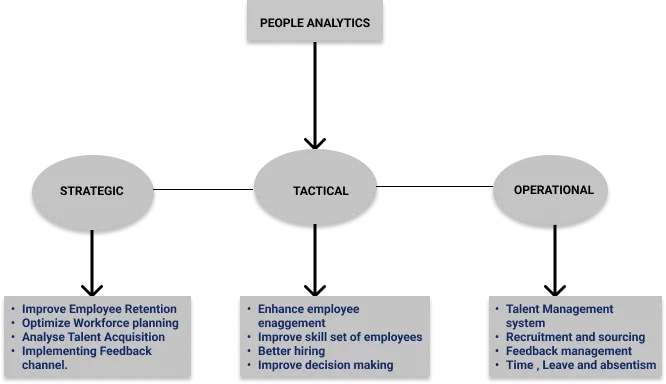ClayHR Explores the Human Side of AI in Hiring — Discover, Debate & Learn. Register Now

Economic and management theory holds that we cannot improve what we have not measured. From piece work to salaried decisions, work is a measurable function of human behavior. So, complex organizations have embraced People Analytics, a field of study that draws valuable insights from people’s behavior at work.
Data-driven People Analytics has used digital resources to monitor employee performance for some time. It has focused on work in time, place, and function−the number of calls made, the quality of sales closed, the number of widgets manufactured, and so on. Managers would recognize high scores and seek to correct the action of those workers with low scores.
However, emerging technologies have advanced People Analytics, helping employers use employee data to integrate organizational functions, goals, and customer-centric outcomes. Advances in data access, cloud-based resources, and a new understanding of employee behavior have made People Analytics an indispensable corporate decision driver.
Scoring employee performance with checkboxes, sliding scales, and weighted metrics wastes employee and manager time and effort. Such legacy assessments only measure the most recent manager observation and subjective impression. Organizations have long recognized this approach lacks depth and predictability, and they have done away with those annual reviews in favor of managing workforce planning.

Work and workers are more accessible to measurement thanks to “smart” machines. Machines and mobile devices now count tasks attempted and those completed, and they feed information to inter-related functions like inventory, shipping and receiving, logistics, and more.
Employers can monitor systems and procedures in real-time, recording and sharing observations on project management. The data access simplifies manager reports and reduces subjective responses.
Managers can take real-time corrective action with timely feedback or device adjustment. For example, skilled workers have long operated CNC Lathes. They can program the machine to produce a specific cut a certain number of times. Engineers developed CNC Lathes that would correct the cut as parts like drill bits wore down. Improved technology now shares the information with managers and across organizational functions and locations.
White-collar workers might wear devices on their wrists, lanyards, or phones to gather and transmit data on performance, wellbeing, and situation response.

The Cloud has made this data gathering and deployment less cumbersome. The size of the data does not burden the organization’s servers. Employers can seek bids for systems and software that make the accumulation and integration possible.
Employers need not create or optimize their assets. Organizations benefit from a third-party capability in customizing resources to fit their specific needs. After all, workers and their work represent only one system in a complex organization’s “System of Systems.”
Organizations have slowly realized the complexity of human behavior. They have come to understand employees and their work function in unique contexts. Workers and their work respond to fluid environments, altered tasks, external contexts, and much more.
Employees have pressed employers to rethink work because of the COVID pandemic and political and economic divisiveness. Workers are looking for a new social contract respecting their work as customer-centric, contributing to change for the better, and matching performance with equitable wages.
Skilled and unskilled labor wants recognition for talents at work. Workers value systems that measure their talent at work rather than the volume of their outputs. They want organizations to hear their voices, respect their inputs, and integrate their feedback. Improved data gathering and deployment empowers and sustains their talents.
HR has traditionally considered itself a “liberal art.” It has valued technology that relieves it from tedious administrative tasks. But legacy HR has not embraced advanced technology. However, it will find People Analytics indispensable.

People Analytics presents some challenges. Employees will resist buy-in to the idea of comprehensive monitoring. HR must communicate values, confidentiality, and ethics in data use. However, the advantages to employees and employers outweigh the problems.
People Analytics puts some teeth in the cliché that claims, “People are our greatest asset.” It does so by seeking patterns in the data generated by worker behavior. It examines talent at work and concludes how the organization can nurture, retain, and replace it with data-driven workforce planning.
Marketing analytics has taken the lead in analytic technology. Google, Amazon, and other pioneers continuously update shopper profiles based on their behavior. People Analytics seeks to build similar profiles on workers at work.